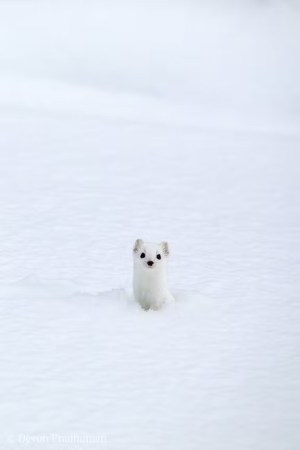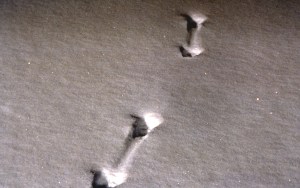The Snowy Wonders of Yellowstone: Why Weasels Turn White in Winter

Photo Courtesy Al DeNoise
Yellowstone National Park is a winter wonderland with its pristine, snow-covered landscapes and abundant wildlife. Among the park’s most fascinating creatures are the weasels, which seem to perform their own magical transformation as they turn the color of their fur and hair coats, called pelage, from a sleek, chestnut brown to pure white in the winter. Join us on a fantastic voyage into the world of Yellowstone’s weasels to uncover the secrets behind their winter transformation.
Weasels are known for their quick and agile nature. Their ability to change coat colors in accordance with the seasons, however, is one of their most remarkable tricks. In the warmer months, the weasels’ rich brown fur helps them blend into Yellowstone’s forested landscapes. Then, when daylight hours shorten to indicate impending winter weather, they undergo a snowy makeover.
As the temperature drops and the days become shorter in Yellowstone, the weasels here molt their summer coats, and their winter fur grows in a brilliant white. This transformation is all thanks to the specialized cells in their fur, which respond to changing day length. This incredible adaptation helps them blend into their snowy surroundings, making them nearly invisible to prey and predators alike. In Yellowstone’s harsh winter, finding food becomes a challenge. By turning white, weasels can sneak up on their prey, like voles and mice, with stealth and precision. It’s survival of the sneakiest in Yellowstone’s winter wonderland!

Distinctive tracks indicate a weasel bounding through the snow. Photo courtesy NPS-Yell.
Weasels’ color-changing trick is driven in part by a hormone called melatonin, which affects the production of melanin-related pigments in their fur. As the days get shorter in preparation for winter, melatonin levels rise, suppressing melanin production and causing the new coats to grow in without color. When summer rolls around and days get longer, melatonin levels decrease, helping spur melanin production, and the summer coats grow in dark again.
Yellowstone’s weasels are true winter wonders. Their ability to change their fur color to blend with the snowy landscapes is a captivating example of nature’s adaptations. As you explore this iconic national park during the winter months, keep an eye out for these elusive creatures. And the next time you spot a weasel, you’ll appreciate the science and magic behind their snowy transformation. It’s just one of the many enchanting stories that make Yellowstone National Park a true wonder of the natural world.
Content provided by Yellowstone Wild Guide Matt DeMassino. Photos courtesy Al DeNoise (top) and Yellowstone National Park (center and bottom).

To learn more about Matt and the rest of the Yellowstone Wild team visit our “About Us” webpage.
